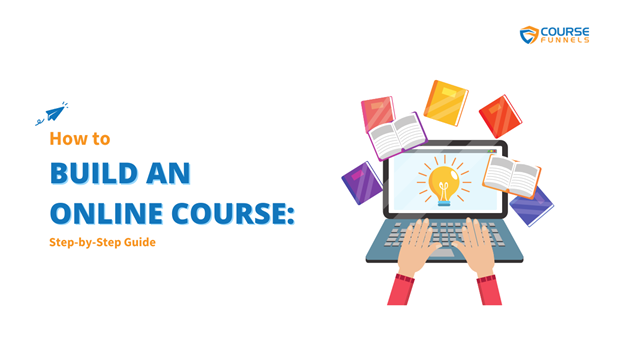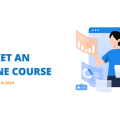If you’ve been thinking about how to build an online course, this guide is for you. With online learning growing quickly, people everywhere can learn new skills and gain knowledge without leaving their homes.
Whether you’re skilled in a certain area or just love teaching, there’s an opportunity for you in the booming online education world.
But the question often comes up: Is selling online courses profitable? The answer is yes.
The e-learning industry is booming, worth over $100 billion worldwide. Online courses are a great way for educators to reach large audiences without spending much. With the right plan, teaching online can become a profitable and impactful way to earn.
In this article, you will go through the process of building an online course, from planning to adding the finishing touches that make it stand out, and recommend some good tools for putting your great ideas into action.
What Is an Online Course?
Before building your online course, let’s define what it is: An online course is a structured digital learning experience that usually includes:
- Written and video lessons
- Self-paced learning modules
- Interactive elements such as quizzes and assignments.
- 24/7 accessibility
- Certified upon completion
Online courses make education accessible to everyone, enabling experts to teach and learners to gain knowledge from anywhere, at any time. Learners are attracted to online courses because they offer flexibility, allowing participants to learn at their own pace. They also let creators design an engaging virtual space for effective learning.
11 Essential Steps to Building Your Successful Online Course
Step 1: Pick a topic for your course.

The first step is to identify your area of expertise. The base of any successful online course lies in its topic. Here’s how to nail it:
A. Tap into your superpower: Consider areas you’re passionate about and can speak on authoritatively. Your expertise is the foundation of your course content.
B. Dive into market research: Use tools like Google Trends and keyword research to gauge demand for your topic. You can also examine current trends and market needs. Look for gaps in existing courses or emerging topics that have high interest.
C. Find your golden niche: Narrow down your focus to a specific area where you can truly excel and meet learner needs.
Step 2: Define Your Target Audience
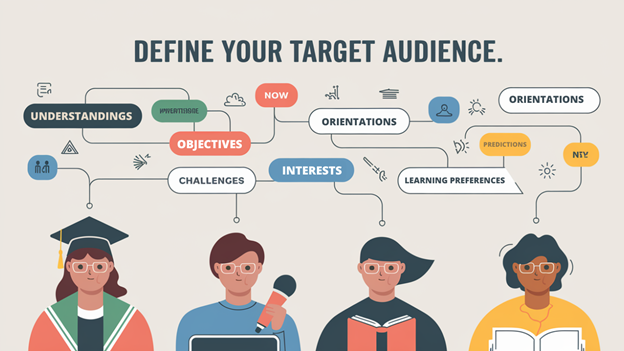
Knowing who you want to sell your online course to is just as important. Understanding your target audience is crucial. Follow these steps:
A. Create student personas: The next step is to clearly define your target audience. Who are they? What are their objectives, challenges, and learning preferences?
B. Understand learner needs: Dive deeper into the needs of your audience. What problems are they trying to solve? What skills do they want to acquire? Understanding their motivations will help you create content that directly addresses their needs.
C. Design Your Course for Your Audience: With a clear understanding of your audience, customize your course content and delivery style. For instance, if your target learners are busy professionals, consider creating short, actionable lessons that can be completed in 30 minutes or less.
With Coursefunnels, you will be setting up your courses and landing pages in no time at all and it makes your work easy as a beginner on route.
Step 3: Research the topic thoroughly.

Whether you’re already an expert or just starting to learn, now is the time to dive deep and master your topic.
Explore various sources like books, competitor courses, and webinars. Do keyword research to understand what questions people are asking about the topic, which will help you tailor your content to their needs.
For instance, if you’re teaching a course on video creation and editing, cover the basics like how to record and what about lighting. But to add value, find unique angles, such as discussing the tools and how to use them.
Step 4: Plan Your Course Content
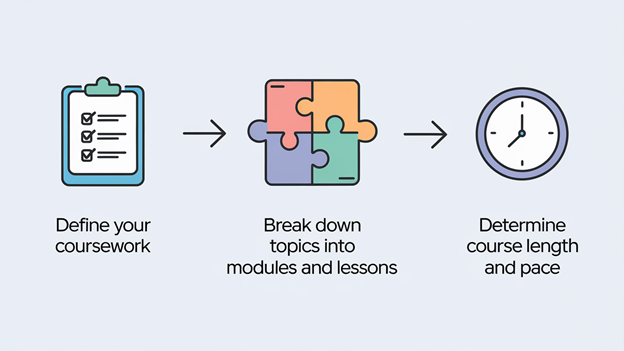
After completing this research, it is time to discuss the specifics of creating the course.
A. Define Your Coursework: Now that you know your audience and topic, it’s time to plan your course content. Start by outlining the key concepts you’ll cover in your course.
B. Break Down Topics into Modules and Lessons: Set up your course into modules and lessons to make the learning easier. Each module should cover a specific area, and each lesson should focus on a particular aspect of that module.
C. Determine course length and pace: Decide how long your course will be and how you’ll pace the lessons. While some courses take weeks to finish, others can be finished in a few hours. Consider your audience’s time limitations and preferences when planning the pacing.
Step 5: Design Your Online Course Materials
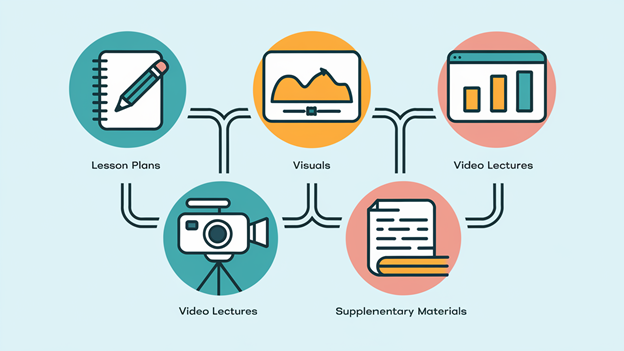
This step creates high-quality course materials that will engage and educate your clients and students. This may include:
A. Lesson plans: Write detailed outlines for each lesson, including key points, examples, and study materials.
B. Visuals: Use slides, infographics, flow charts, and other visuals to enhance understanding and retention.
C. Video lectures: Record high-quality video lectures with good lighting and audio settings that deliver your content effectively.
D. Supplementary materials: Provide additional resources such as worksheets, quizzes, PDFs, and case studies to reinforce learning.
With the help of CourseFunnels, you can create hundreds of premade templates and styles. With the robust page builder, you can quickly select a page and make the necessary changes.
Step 6: Choose Your Course Platform
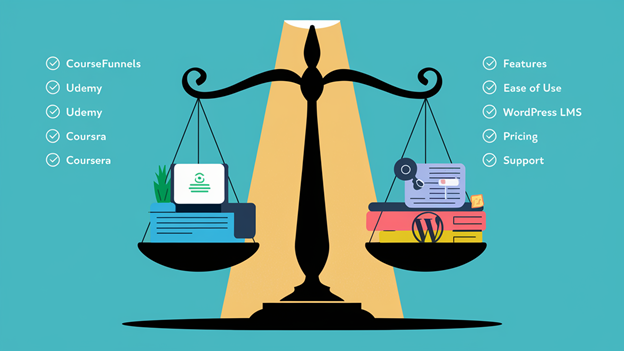
Making the best platform choice for your course is the next step. Different platforms have their benefits and drawbacks.
A. Compare popular online learning platforms: Evaluate platforms like Coursefunnels, Udemy, and Coursera based on their features, ease of use, pricing, and support. Each platform has unique benefits, so choose one that aligns with your needs.
B. Consider Self-Hosting Options: Explore self-hosting if you prefer more control over your content and branding. Tools like WordPress with LMS plugins can offer flexibility and customization.
C. Compare Features and Pricing: Analyze the features offered by each platform, such as payment processing, marketing tools, and student analytics. Balance these features with the cost to find the best fit for your budget.
However, remember that the quality of your course content and platform are both important. Taking everything into account, CourseFunnels is the only platform that can help you create engaging courses and effectively sell them because of its six profit-boosting plugins.
Step 7: Set-up your online course.

Getting your course ready for prime time is crucial. A well-organized, user-friendly course structure can significantly impact student engagement. Get your course ready for prime time:
A. Upload like a Pro: Transfer your course materials, including videos, documents, and visuals, to the chosen platform. For your course, logically arrange them.
B. Structure for Success: Ensure your content is arranged in a logical order, with clear navigation between modules and lessons.
C. Fine-tune access: Set up course settings, including enrollment options, pricing, and access permissions. Before launching, make sure everything is working as it should.
Step 8: Set your course pricing.
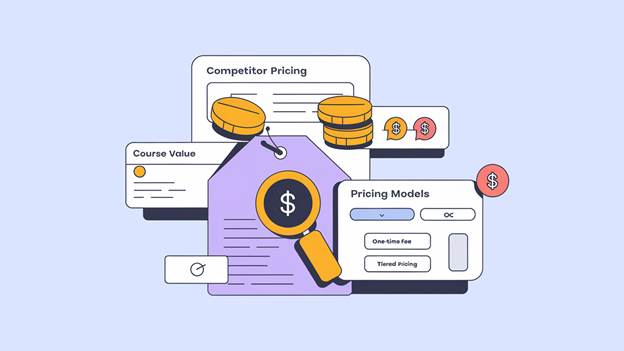
So we can consider this step important because pricing can make or break your course’s success.
A. Spy on competitor pricing: Investigate how similar courses are priced. You can position your course more competitively by doing this.
B. Consider Your Course Value: Price your course based on its value, the quality of content, and what your target audience is willing to pay.
C. Consider the Pricing Model: Choose a pricing model that suits your course and audience, such as a one-time fee, subscription, or tiered pricing.
Step 9: Now Market Your Course!
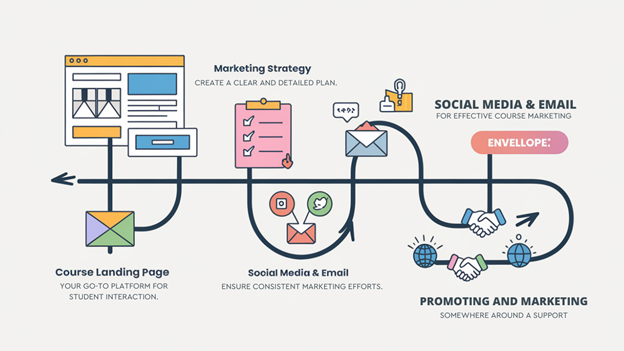
Creating an online course is only 50% of the work. The other 50% begins when you launch it. It’s crucial to manage, market, and track your course. Even the best course needs good marketing, so:
A. Create a Strong Course Landing Page: Your landing page is the first thing students see. Make it attractive and clearly explain the benefits of your course to encourage enrollment.
B. Come up with a marketing strategy: Create a strategy to reach your target audience. This can include content marketing, social media, paid ads, and email campaigns.
C. Use Social Media and Email Marketing: Promote your course on social media to build interest. Email marketing is also a great way to connect directly with potential students.
D. Consider Partnerships and Affiliates: Work with influencers, bloggers, or affiliates in your field to promote your course. These partnerships can help you reach more people and increase sign-ups.
It can be difficult to manage and market your course, but CourseFunnels has you covered. It offers long-term marketing support with built-in tools and email marketing features to help promote your courses effectively.
Step 10: Launching and Gathering Feedback
Customer testimonials can be more convincing than your own words. Collect feedback from satisfied customers and use it to showcase the success of your course on your landing page and in your marketing. Thus, the launch is only the start.
A. Soft Launch to a Small Group: Release your course to a select group of users before the full launch. This allows you to test the course and make any necessary adjustments.
B. Collect and Analyze the data: To figure out your strengths and potential fields for progress, get feedback from early adopters. Collect insights via personal interaction, tests, and surveys.
C. Make necessary improvements: Implement changes based on feedback to enhance the course content, user experience, and overall quality.
Coursefunnels allow you to create and sell courses while utilizing tremendous learning. You can get rich learning experiences with assignments, quizzes, interaction, and multiple document types supported.
Step 11: Continually Improve and Update
This is the final step, but it is also one of the most important because it involves not only creation but also continuous improvement. You should keep in mind that:
A. Track Progress and Engagement: Track student progress and engagement to identify trends and potential issues. Use this data to refine your course.
B. Stay Ahead with Trends: Keep up with trends in your subject area and online education to ensure your course remains relevant and valuable.
C. Regularly Update Course: Refresh and expand your course content periodically to keep it up-to-date and aligned with the latest developments.
Conclusion: Your path to online course success begins now.
Creating an online course is a rewarding journey that can turn your passion into profit. By following this step-by-step guide, you’re on your way to building a course that educates, inspires, and empowers your students. Success comes from continuous improvement and adapting to your student’s needs.
Ready to get started? Begin planning your course today, and let CourseFunnels help you succeed. With six profit-boosting plugins and support for 17 languages, this platform offers powerful tools to optimize your course sales and maximize your success.
If you’re ready to turn your expertise into a thriving online course, explore CourseFunnels and start your journey toward becoming a successful online educator!
How to Build an Online Course FAQ
Q. How do I choose a course topic?
Ans. Consider your areas of expertise and passion. Research market demand to ensure there is interest in your topic.
Q. How do I define my target audience?
Ans. Create student personas to represent your ideal learners. Consider their age, education level, experience, goals, and challenges.
Q. What should I include in my course content?
Ans. Your course content should be well-organized and engaging. Include lectures, videos, quizzes, and other supplementary materials.
Q. How do I price my course?
Ans. Research competitor pricing and consider the value of your course. You can choose a one-time fee, a subscription, or a bundled package.
Q. Which platform is ideal for creating an online course?
And. CourseFunnels, Coursera, and Thinkific are a few of the excellent platforms available. Budget and individual needs will determine which option is best for you. CourseFunnels stands out because it not only helps you create engaging courses but also supports effective course sales.

